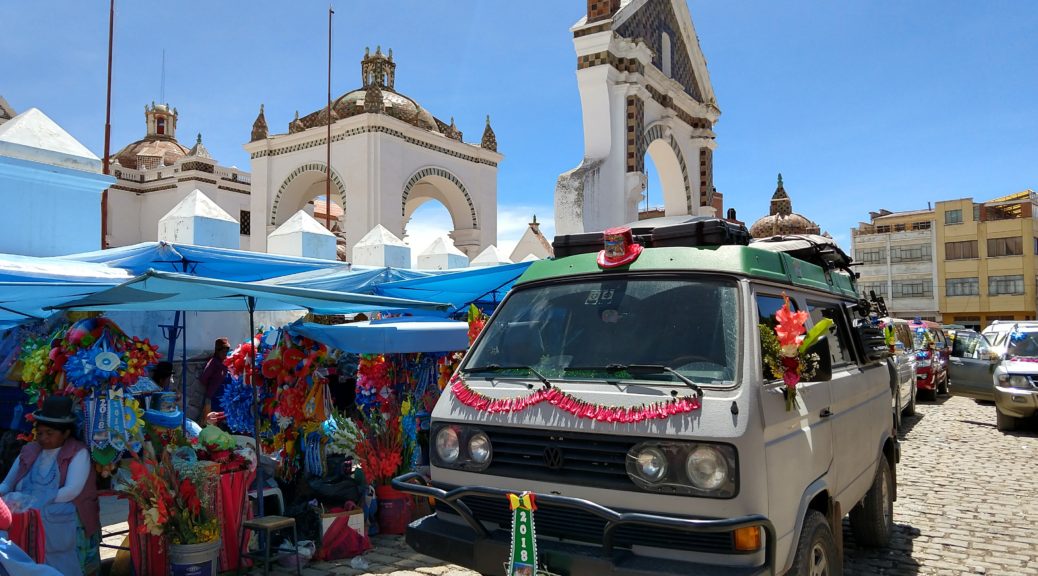
Bolivian Beginnings
From desolate and trashed desert wastelands to unbelievable and mysterious heights with endless coast throughout, Peru left us full of shockingly vivid memories. Traversing south and east out of Cusco, we were high in elevation and ready to experience a new country, Bolivia. 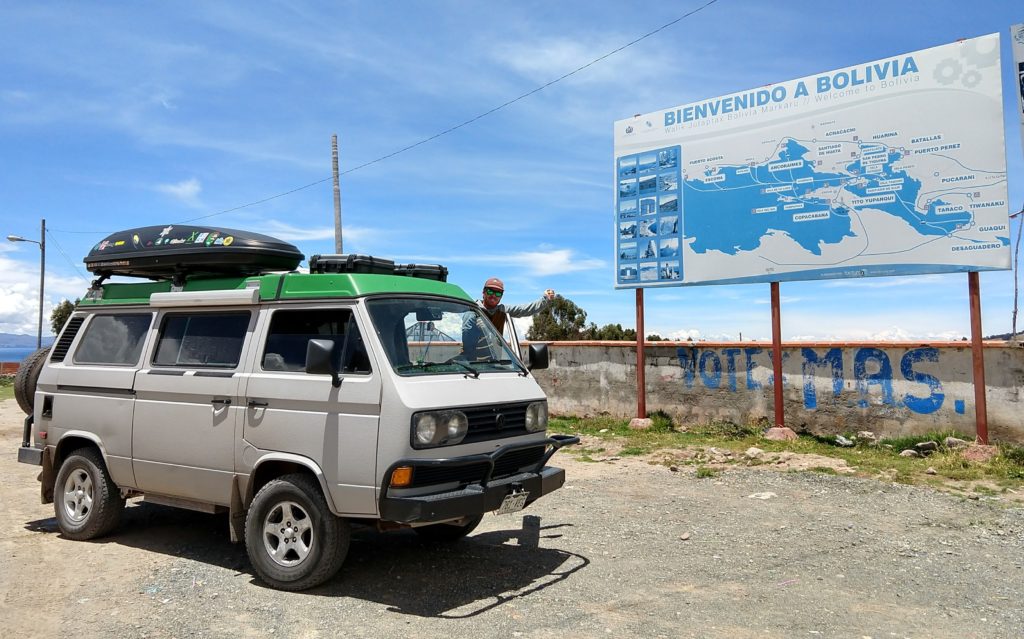 We were excited and curious to explore this unknown and underappreciated country.
We were excited and curious to explore this unknown and underappreciated country. 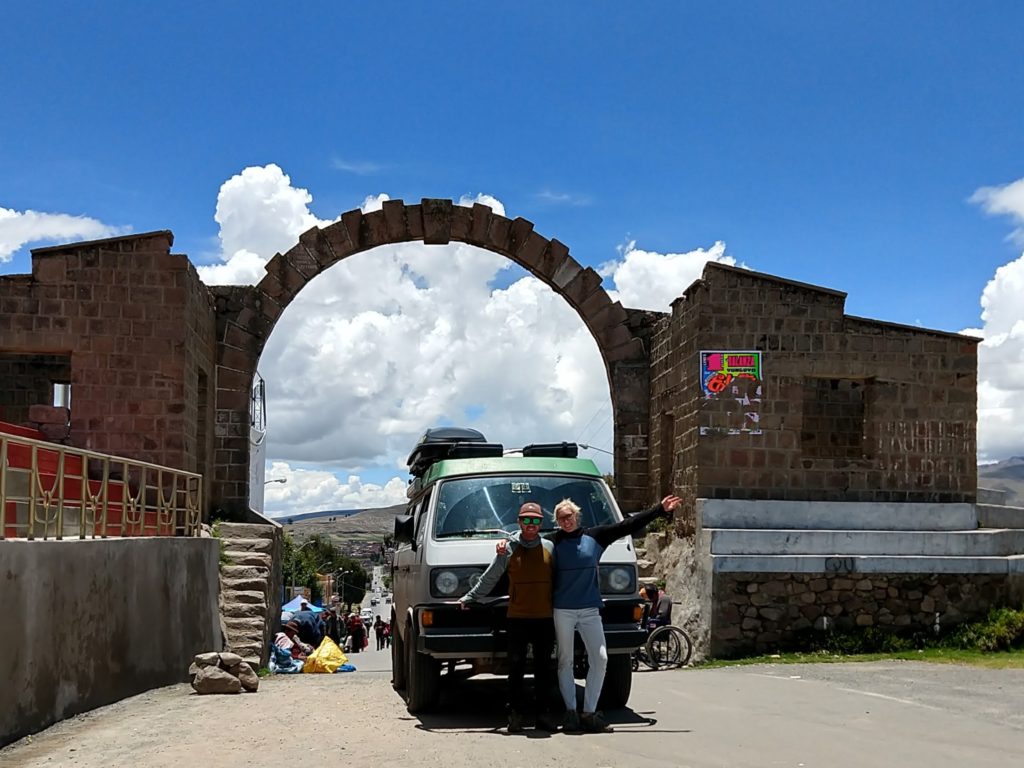 Our border of choice cut through the famous and highest fresh water lake in the world, Lake Titicaca.
Our border of choice cut through the famous and highest fresh water lake in the world, Lake Titicaca. The nearest city over the border and our location for New Year’s Eve was Copacabana, pleasantly located above a protected cove with a nice beach stretching far enough from the town center to provide the locals and tourists alike plenty of space to revel in the festivities.
The nearest city over the border and our location for New Year’s Eve was Copacabana, pleasantly located above a protected cove with a nice beach stretching far enough from the town center to provide the locals and tourists alike plenty of space to revel in the festivities.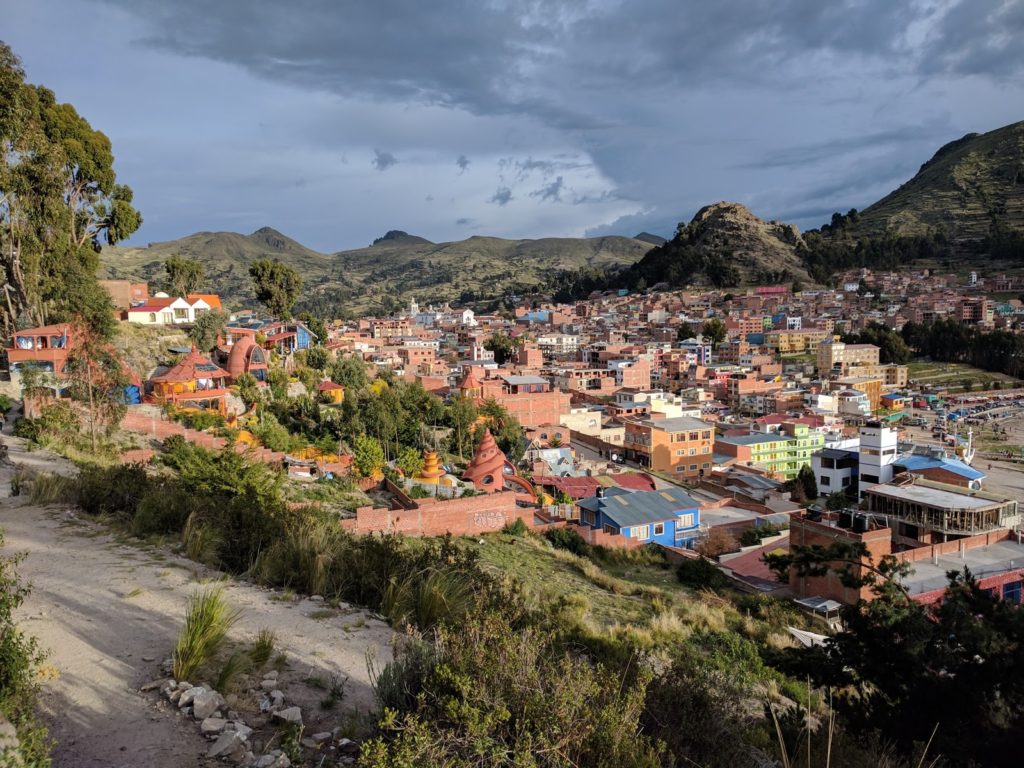 A quick lap through the neatly developed town had us recognize one of it’s most well known traditions, the ‘Blessing of your Car’. That’s right, you drive right up in front of the catholic church, spruce up the car with whatever decorations you’re willing to pay for, and wait for the priest to come and literally bless the car.
A quick lap through the neatly developed town had us recognize one of it’s most well known traditions, the ‘Blessing of your Car’. That’s right, you drive right up in front of the catholic church, spruce up the car with whatever decorations you’re willing to pay for, and wait for the priest to come and literally bless the car. 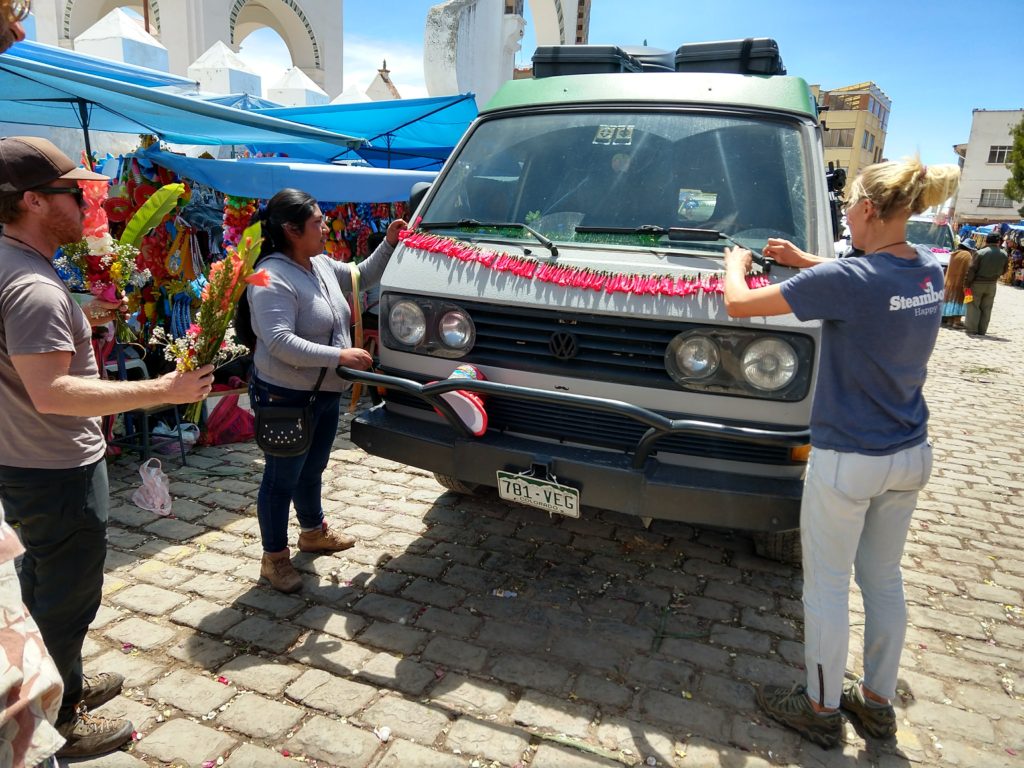 Sarah’s excitement quickly overrode Matt’s weariness of the spectacle, so we put Koru in line for the experience.
Sarah’s excitement quickly overrode Matt’s weariness of the spectacle, so we put Koru in line for the experience. Witnessing families elaborately decorate their cars who’d traveled from all over Bolivia seemingly for this one experience, gave us some excitement for the proceedings. Some people even popped champagne bottles to spray outside AND inside their cars. Joining in the fun, we decorated within our travelers budget and refused any of the foreign liquids from entering Koru.
Witnessing families elaborately decorate their cars who’d traveled from all over Bolivia seemingly for this one experience, gave us some excitement for the proceedings. Some people even popped champagne bottles to spray outside AND inside their cars. Joining in the fun, we decorated within our travelers budget and refused any of the foreign liquids from entering Koru.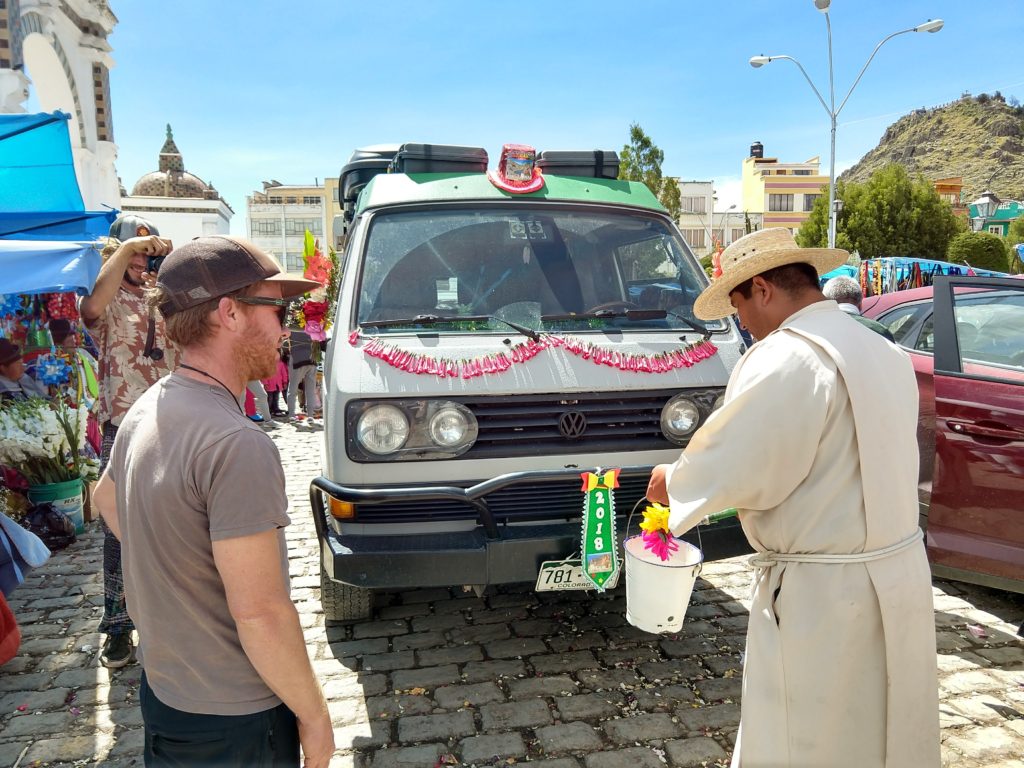 The priest finally came to us and gave the van and ourselves a nice splash of holy water while stopping for a quick photo op before moving on to the next car.
The priest finally came to us and gave the van and ourselves a nice splash of holy water while stopping for a quick photo op before moving on to the next car.  Feeling excited after what proved to be a very unique and Bolivian experience, we parked Koru on a far end of the beach and proceeded to begin the New Year’s celebration.
Feeling excited after what proved to be a very unique and Bolivian experience, we parked Koru on a far end of the beach and proceeded to begin the New Year’s celebration.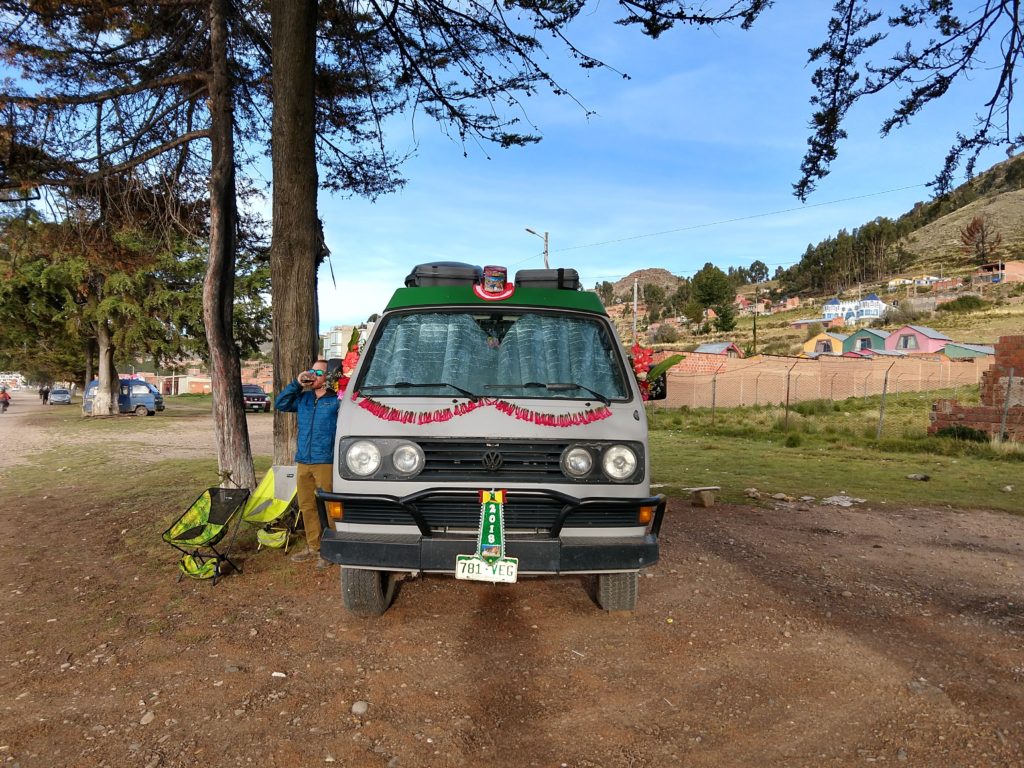
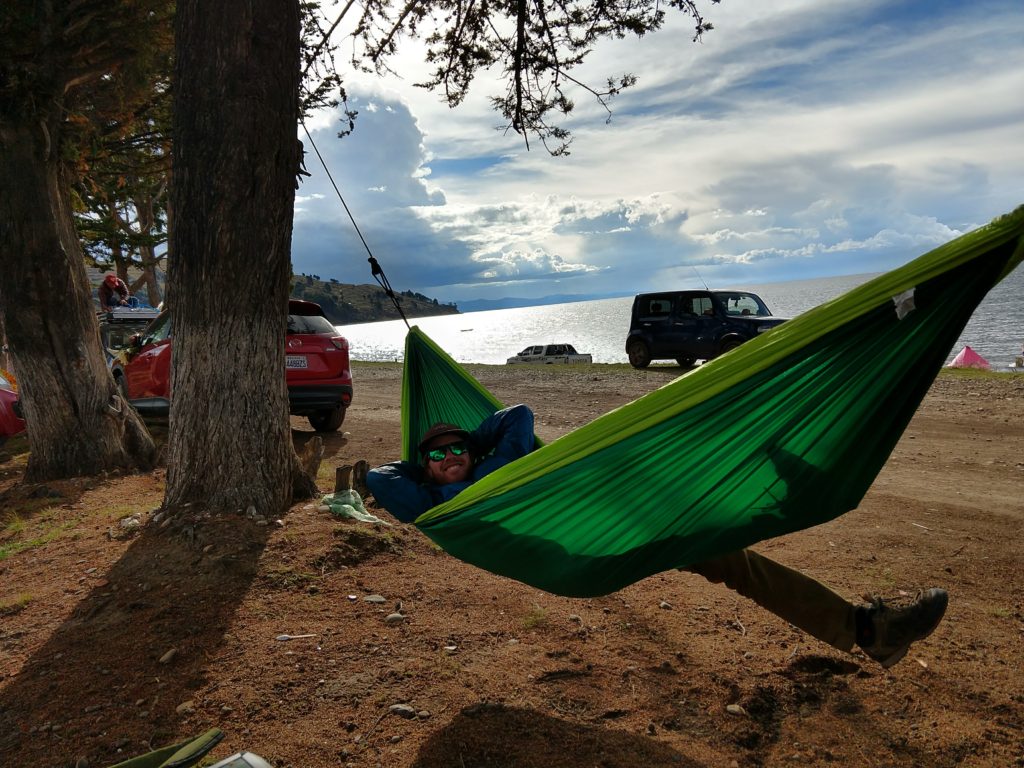 Fireworks dominated the skyline as soon as it was close to midnight and we did our best to avoid getting hit by rogue explosives while raising toasts to the new year.
Fireworks dominated the skyline as soon as it was close to midnight and we did our best to avoid getting hit by rogue explosives while raising toasts to the new year. 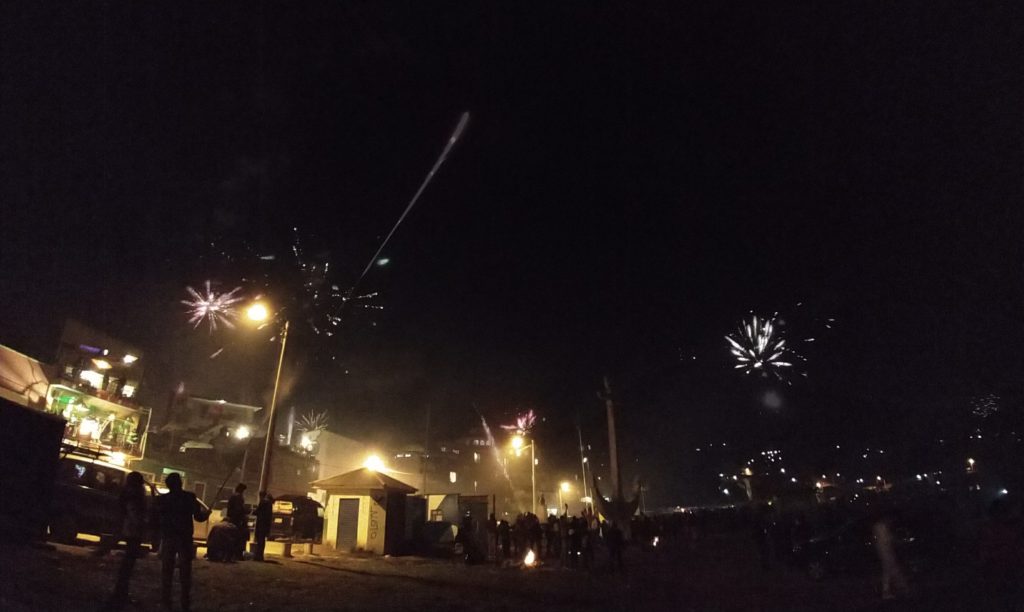 New Years day brought blue skies and nice temperatures for one last round of exploration before heading towards the capitol of La Paz.
New Years day brought blue skies and nice temperatures for one last round of exploration before heading towards the capitol of La Paz. 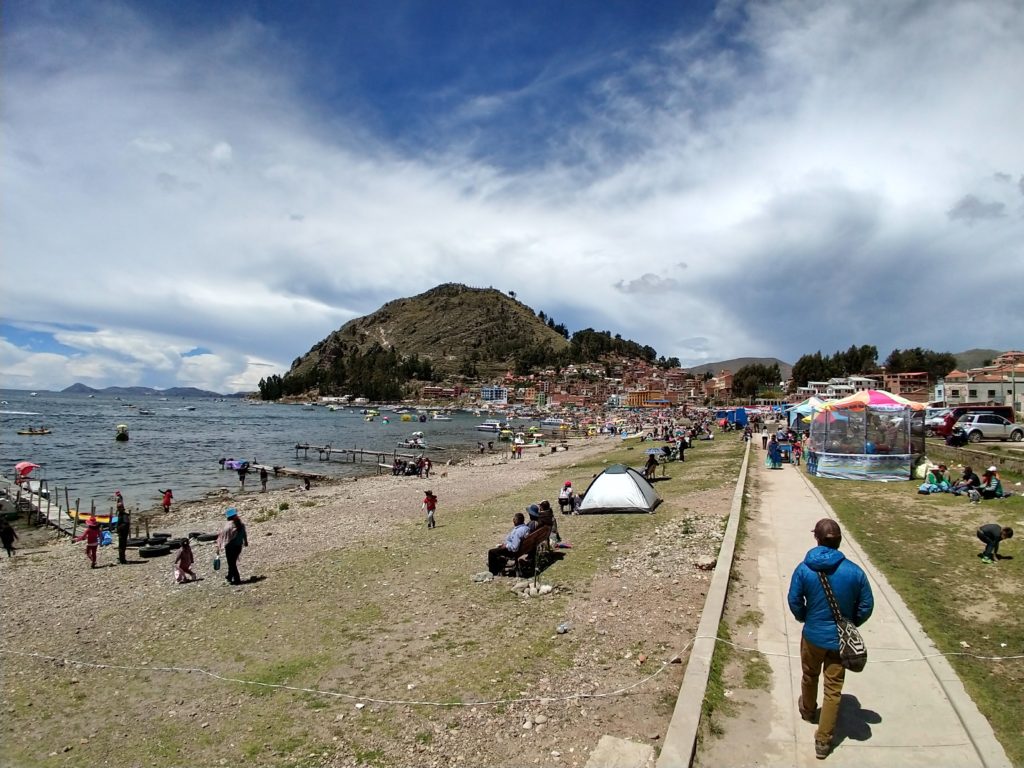
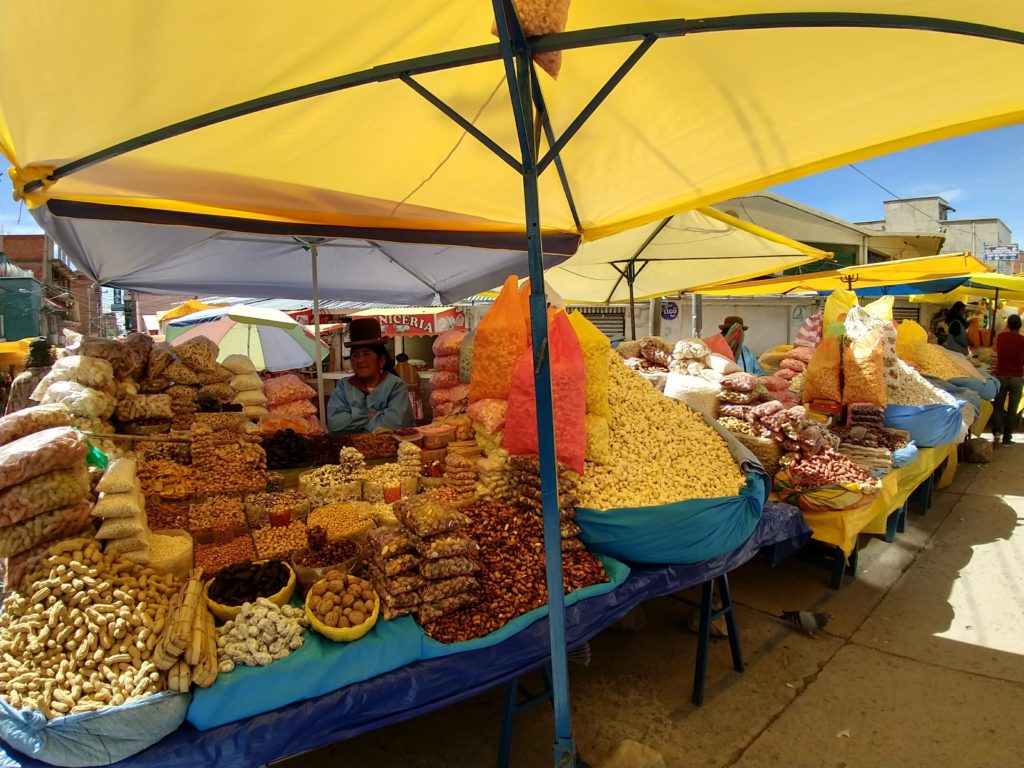 Copacabana is famous for its popped corn, so like the locals, we bought a bag for the road and set off for La Paz.
Copacabana is famous for its popped corn, so like the locals, we bought a bag for the road and set off for La Paz.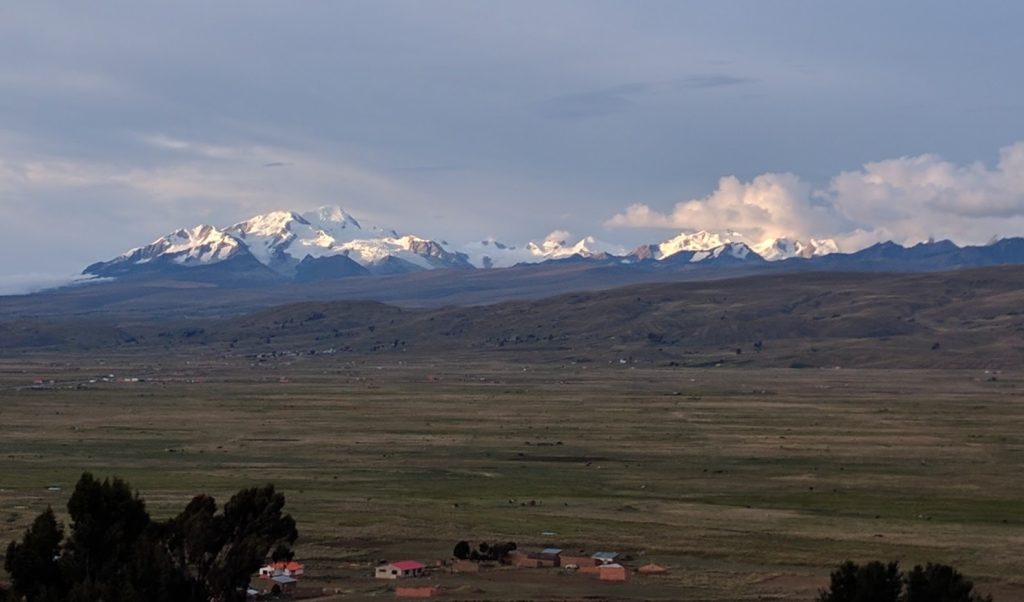 During our departure of the city and onto the Altiplano, we were amazed at how similar the country side reminded us of the high prairies of Wyoming. The Cordillera Real dominated the backdrop getting ever closer as we progressed. However, before we set to a steady cruise, we needed to take a “ferry” across an arm of Lake Titicaca before regaining the highway.
During our departure of the city and onto the Altiplano, we were amazed at how similar the country side reminded us of the high prairies of Wyoming. The Cordillera Real dominated the backdrop getting ever closer as we progressed. However, before we set to a steady cruise, we needed to take a “ferry” across an arm of Lake Titicaca before regaining the highway. 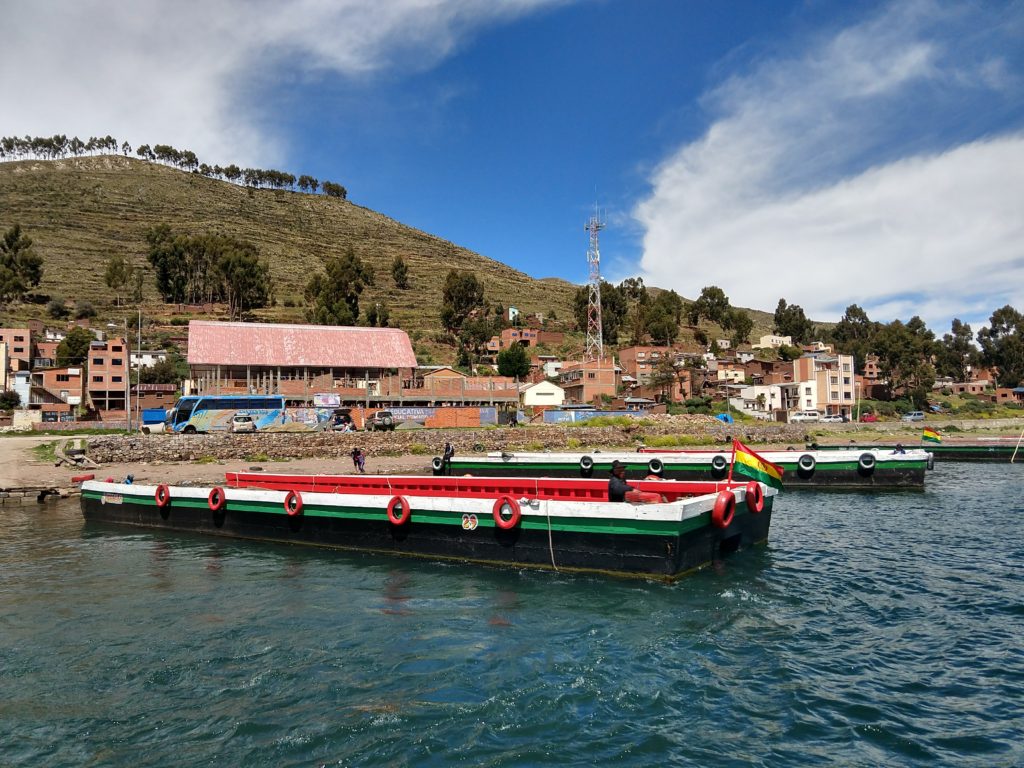 This will likely go down as one of the funniest/scariest/confusing experiences of the trip. As we arrived to the dock, we were shocked to see what appeared to be vehicles, from small cars to large tourists buses, floating by themselves in the lake.
This will likely go down as one of the funniest/scariest/confusing experiences of the trip. As we arrived to the dock, we were shocked to see what appeared to be vehicles, from small cars to large tourists buses, floating by themselves in the lake.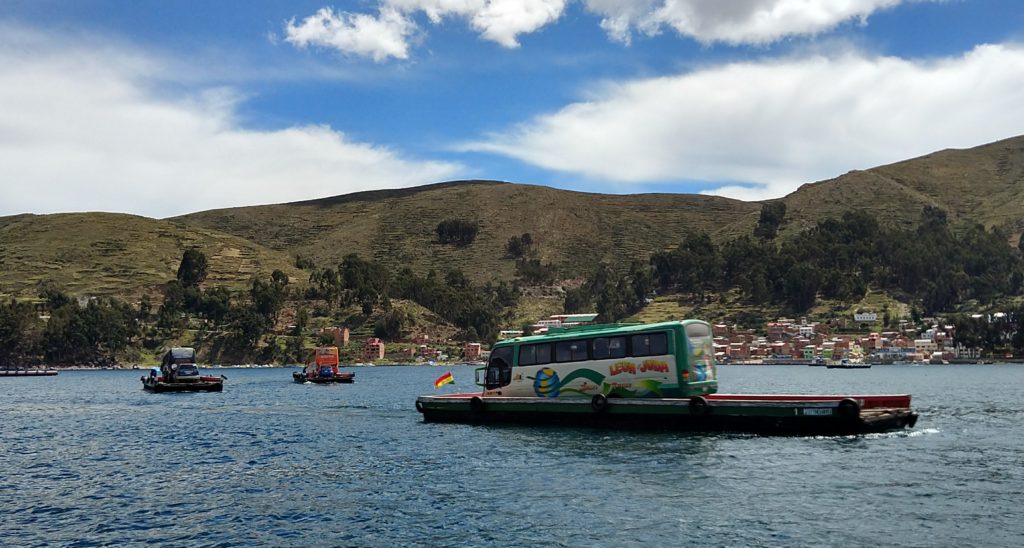 After a closer look, we realized they were floating on small, low profile barges (planks of wood might be a better description) with a motor slowly chugging across the water.
After a closer look, we realized they were floating on small, low profile barges (planks of wood might be a better description) with a motor slowly chugging across the water.  There was zero organization to who went where and when with no navigation lanes, causing some serious head-scratching at the sight.
There was zero organization to who went where and when with no navigation lanes, causing some serious head-scratching at the sight. 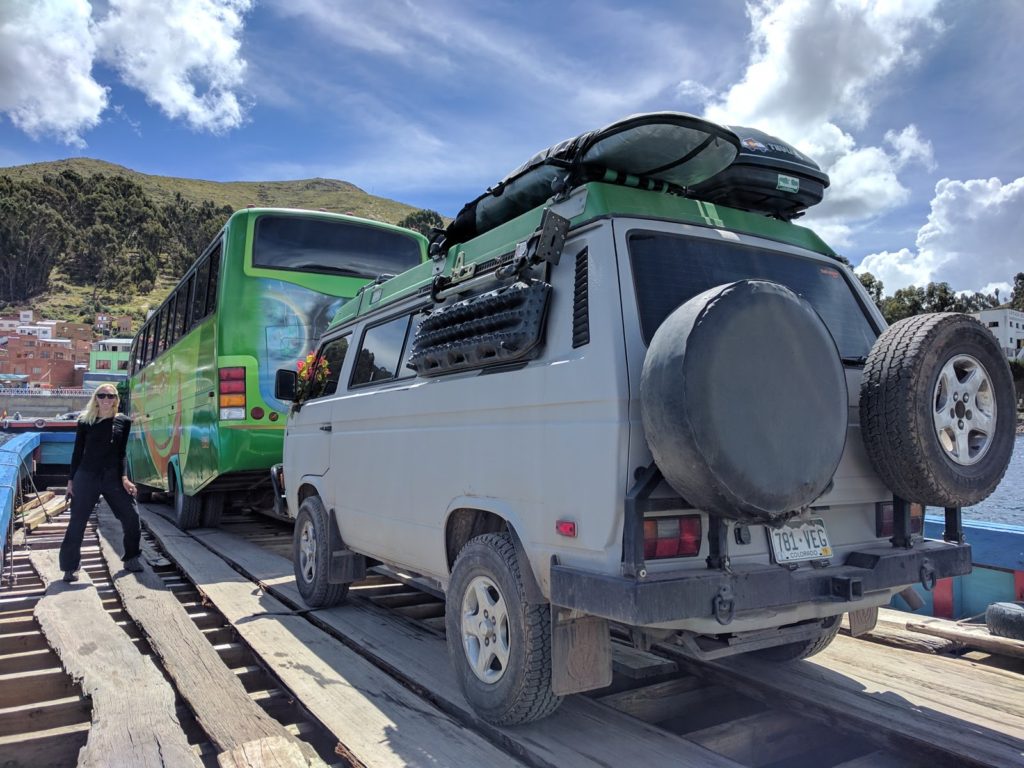 Despite the inherent comedy in the operation, we tried to overcome our sense of worry as we drove Koru onto a barge with a tourist bus where you could see lake water below in the hull.
Despite the inherent comedy in the operation, we tried to overcome our sense of worry as we drove Koru onto a barge with a tourist bus where you could see lake water below in the hull.
With a large stick used to push the barge away from the dock before engaging the motor, the captain ushered us across gracefully and uneventfully.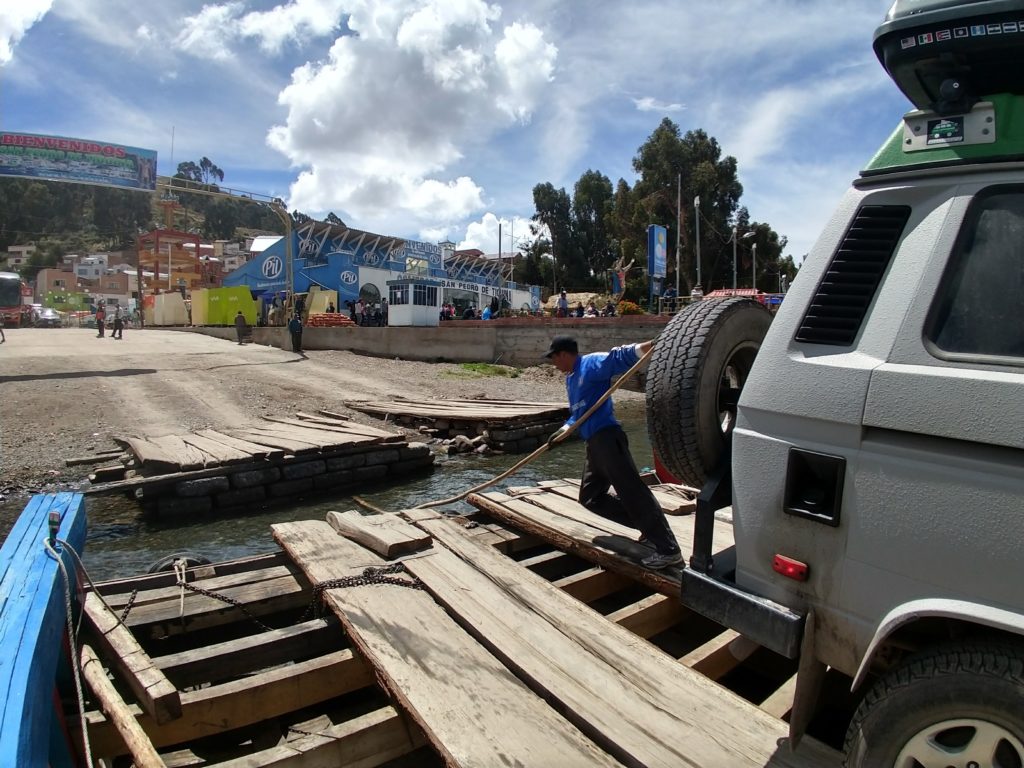 One last look safely from the other side of the lake gave us smiles and sighs of relief as we cruised on. The open road can provide one with a sense of freedom that not much can compare to. This particular stretch in Bolivia re-instilled that sense of freedom to an amazing degree.
One last look safely from the other side of the lake gave us smiles and sighs of relief as we cruised on. The open road can provide one with a sense of freedom that not much can compare to. This particular stretch in Bolivia re-instilled that sense of freedom to an amazing degree.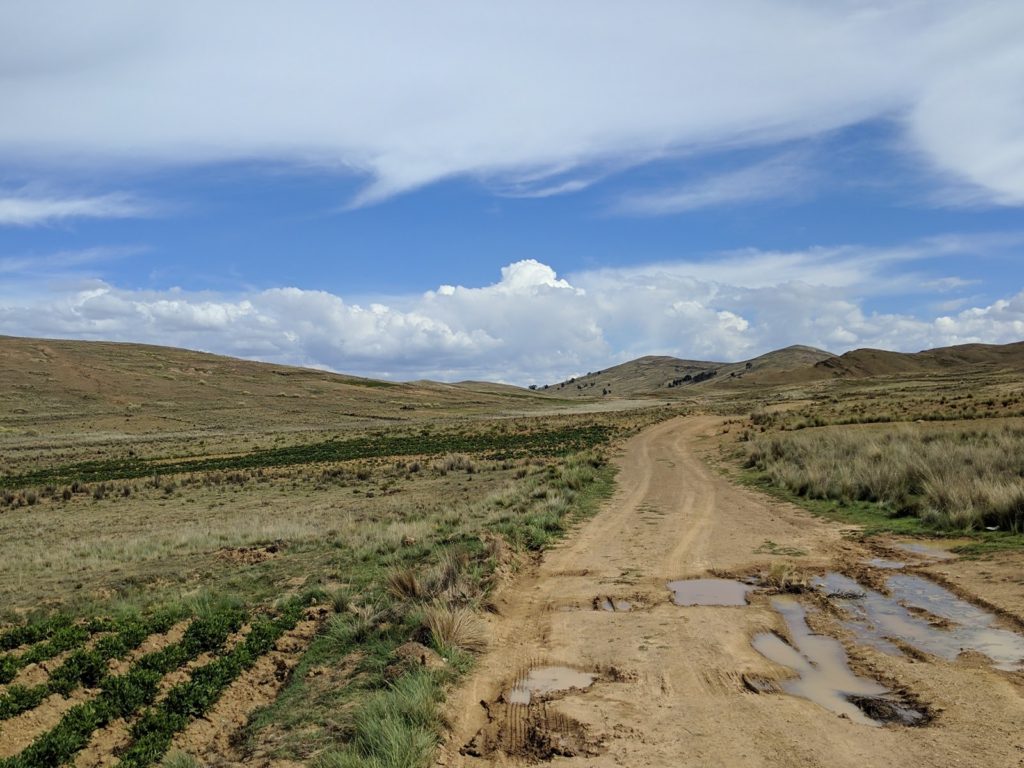 We opted to take a road less traveled to bear witness to the ranch lands and unending views of the mountains and prairie. This led us to a hidden canyon of rock near a small village.
We opted to take a road less traveled to bear witness to the ranch lands and unending views of the mountains and prairie. This led us to a hidden canyon of rock near a small village. The climbing access had us park next to a school where we met some friendly locals working the fields nearby.
The climbing access had us park next to a school where we met some friendly locals working the fields nearby.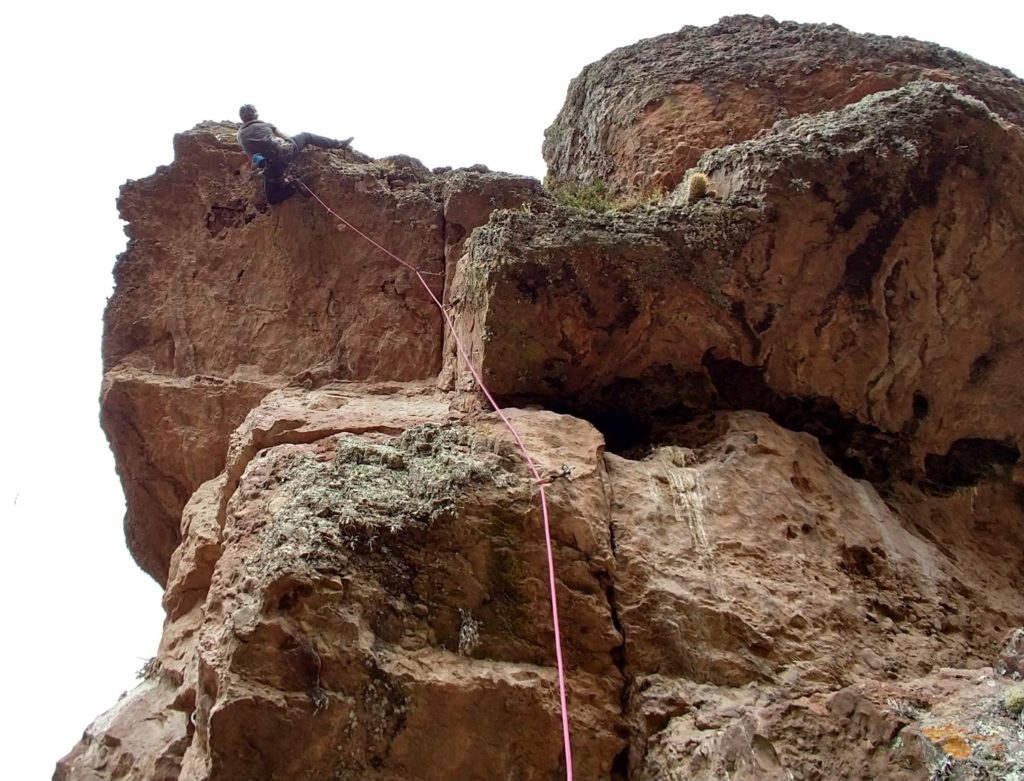 The weather was always on our minds, and with rain coming in almost daily, we tread lightly and knew our time in the high country was limited. After two quick climbing sessions, we continued on towards La Paz on the endless plain at an elevation of 13,000ft! Arriving into the city, we couldn’t see much past a few neighborhoods and small buildings along with modern gondolas knowing there was far more than met the eye.
The weather was always on our minds, and with rain coming in almost daily, we tread lightly and knew our time in the high country was limited. After two quick climbing sessions, we continued on towards La Paz on the endless plain at an elevation of 13,000ft! Arriving into the city, we couldn’t see much past a few neighborhoods and small buildings along with modern gondolas knowing there was far more than met the eye.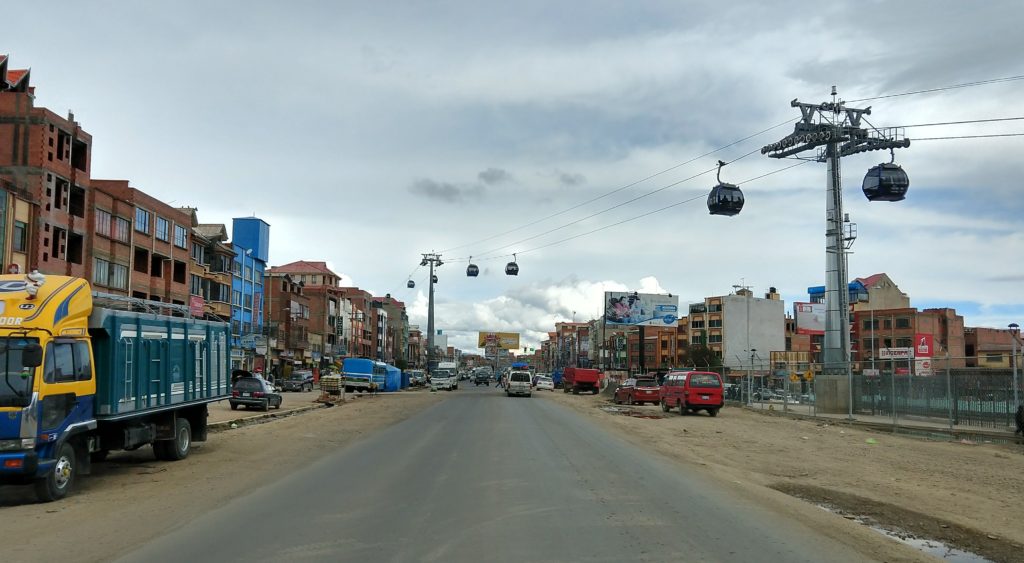 La Paz is located in what most would call a giant ‘hole’ in the ground. The large geologic depression engulfs almost the entire city, creating a dramatic setting with the big mountains on one side, and otherworldly desert rocks encircling the rest.
La Paz is located in what most would call a giant ‘hole’ in the ground. The large geologic depression engulfs almost the entire city, creating a dramatic setting with the big mountains on one side, and otherworldly desert rocks encircling the rest. The location would not seem likely for such a large city, but due to the mineral resources extracted from the ‘hole’, the city’s destiny was permanently set. Fortunately, we had the opportunity to park and sleep in the van at the airport on the Altiplano above the city. La Paz is famous for it’s difficulty to navigate and has unfortunately scared off many overland travelers more so than other big cities in Latin America.
The location would not seem likely for such a large city, but due to the mineral resources extracted from the ‘hole’, the city’s destiny was permanently set. Fortunately, we had the opportunity to park and sleep in the van at the airport on the Altiplano above the city. La Paz is famous for it’s difficulty to navigate and has unfortunately scared off many overland travelers more so than other big cities in Latin America.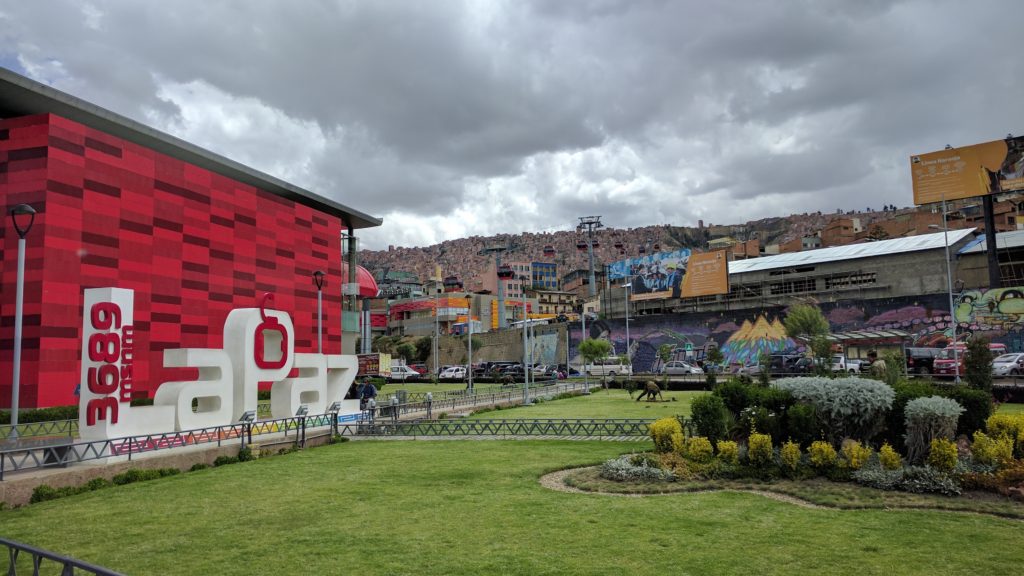 Not feeling afraid, we happily took public transportation to and from the airport which happens to include a series of gondolas thanks to the new President’s agenda at getting the Capitol and Bolivia’s transportation infrastructure on par with the modern world.
Not feeling afraid, we happily took public transportation to and from the airport which happens to include a series of gondolas thanks to the new President’s agenda at getting the Capitol and Bolivia’s transportation infrastructure on par with the modern world. 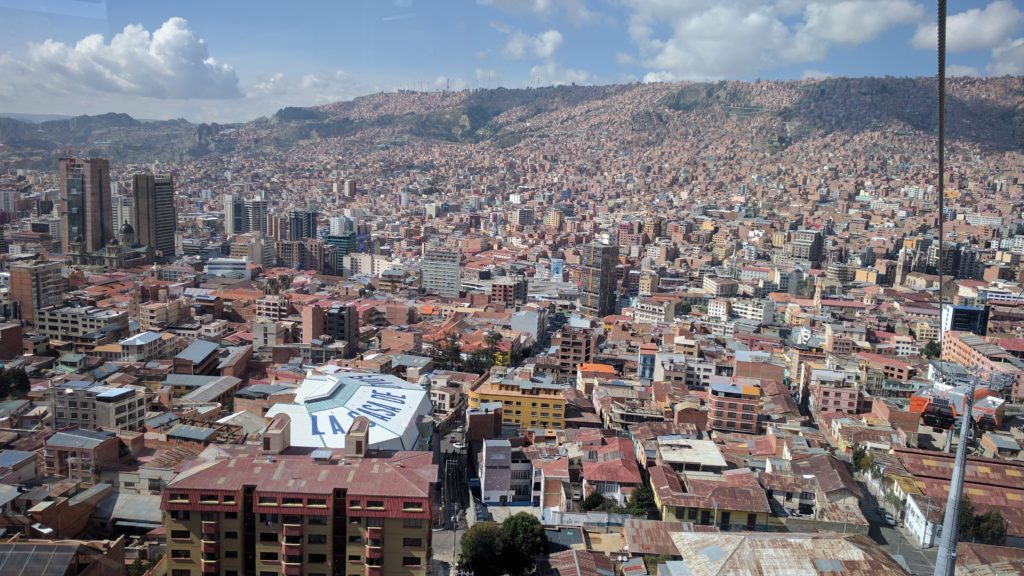 Finally in the city center, we set about to explore. La Paz is famous for affordable textiles and artesanias. In fact, most of what we saw in Ecuador and Peru (sweaters, slippers, tapestries etc.) are made in Bolivia. We were able to find souvenirs here at fractions of the cost in other countries.
Finally in the city center, we set about to explore. La Paz is famous for affordable textiles and artesanias. In fact, most of what we saw in Ecuador and Peru (sweaters, slippers, tapestries etc.) are made in Bolivia. We were able to find souvenirs here at fractions of the cost in other countries.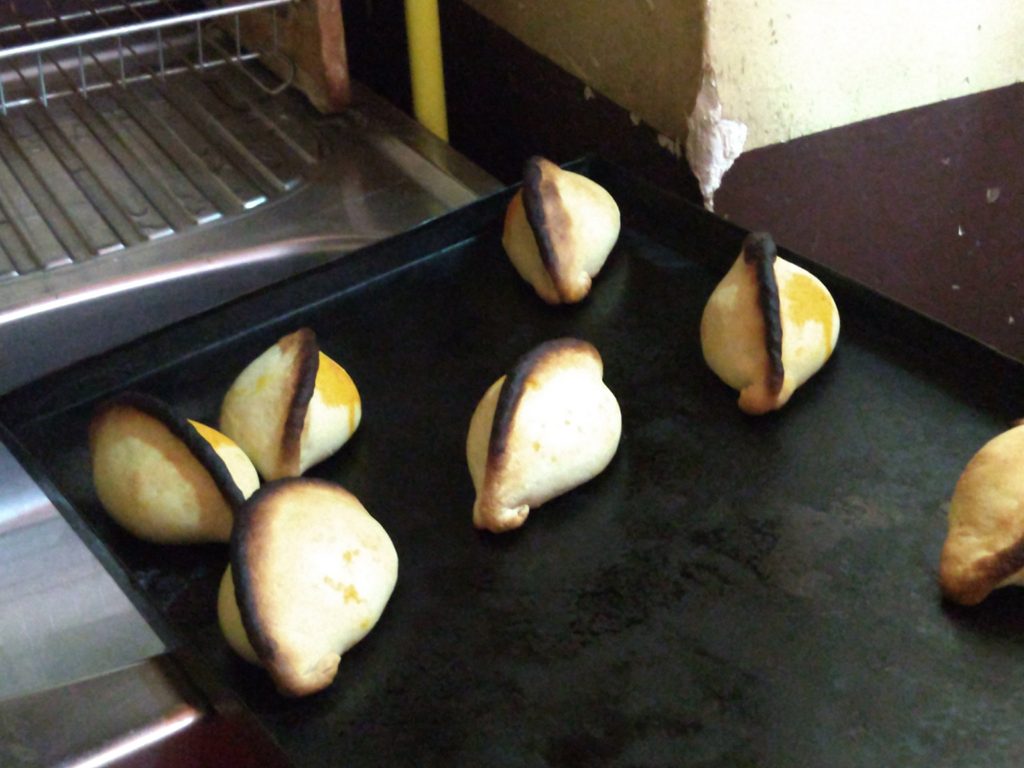 Food is also very cheap, as it is not much of a surprise that the poverty level is unfortunately very high in Bolivia. Despite this, we found some incredibly tasty food and some friendly people to talk to.
Food is also very cheap, as it is not much of a surprise that the poverty level is unfortunately very high in Bolivia. Despite this, we found some incredibly tasty food and some friendly people to talk to. 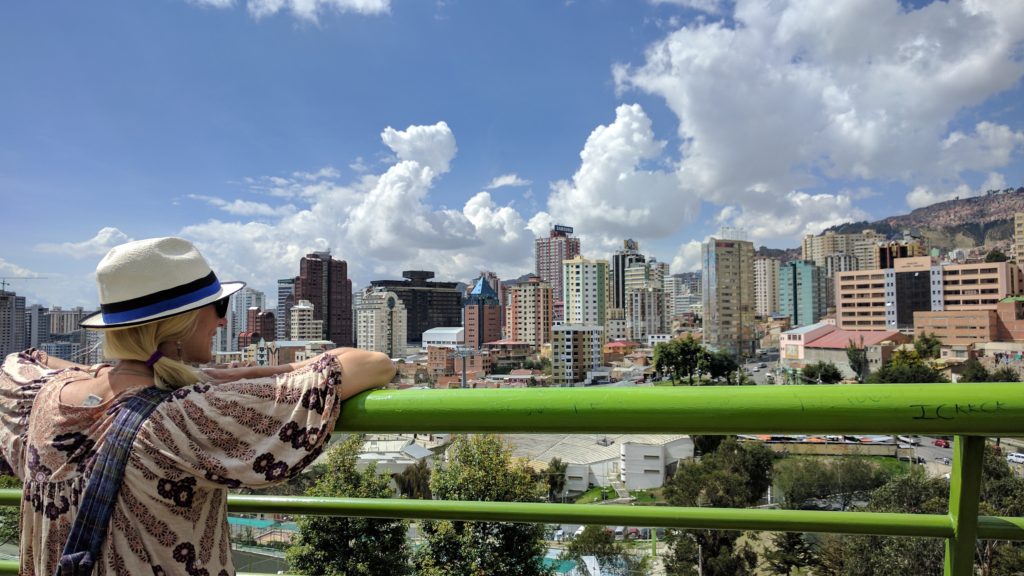 We enjoyed walking around the city center and exploring the secretive little nooks and crannies. There are ‘medicinal’ alleyways where one can discover remedies for almost any illness if they’re are willing to look for it.
We enjoyed walking around the city center and exploring the secretive little nooks and crannies. There are ‘medicinal’ alleyways where one can discover remedies for almost any illness if they’re are willing to look for it.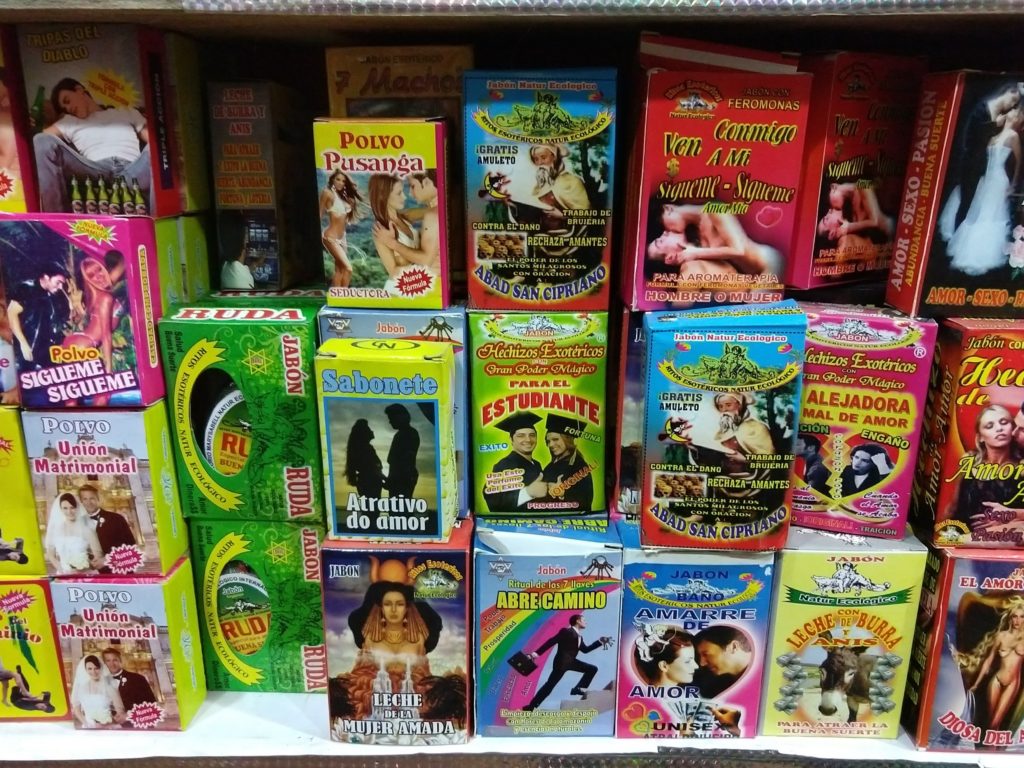 Many describe such alleys and its vendors as dealers of witchcraft, and we found them entertaining nonetheless (see hanging dead lamb above Matt).
Many describe such alleys and its vendors as dealers of witchcraft, and we found them entertaining nonetheless (see hanging dead lamb above Matt).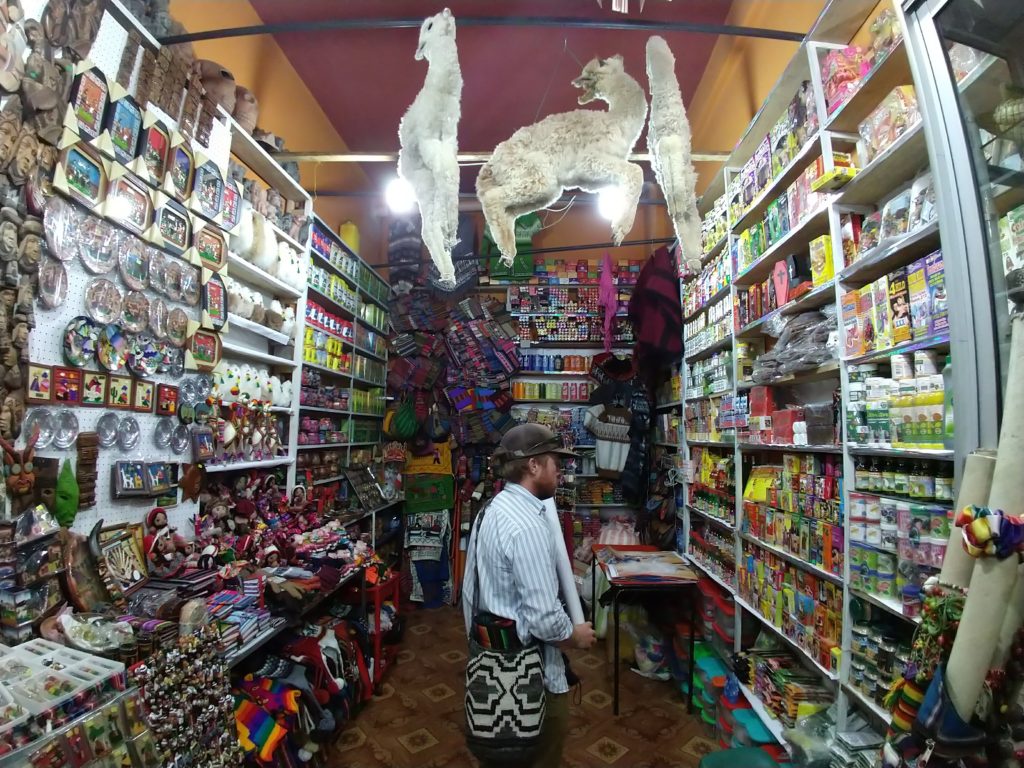 Our final days in the city had us exploring one of the biggest markets in the Americas. No food at this one, just used goods of all varieties. They say if you get something stolen in Bolivia, just go to the market on Thursday or Sunday in El Alto and you will find it.
Our final days in the city had us exploring one of the biggest markets in the Americas. No food at this one, just used goods of all varieties. They say if you get something stolen in Bolivia, just go to the market on Thursday or Sunday in El Alto and you will find it.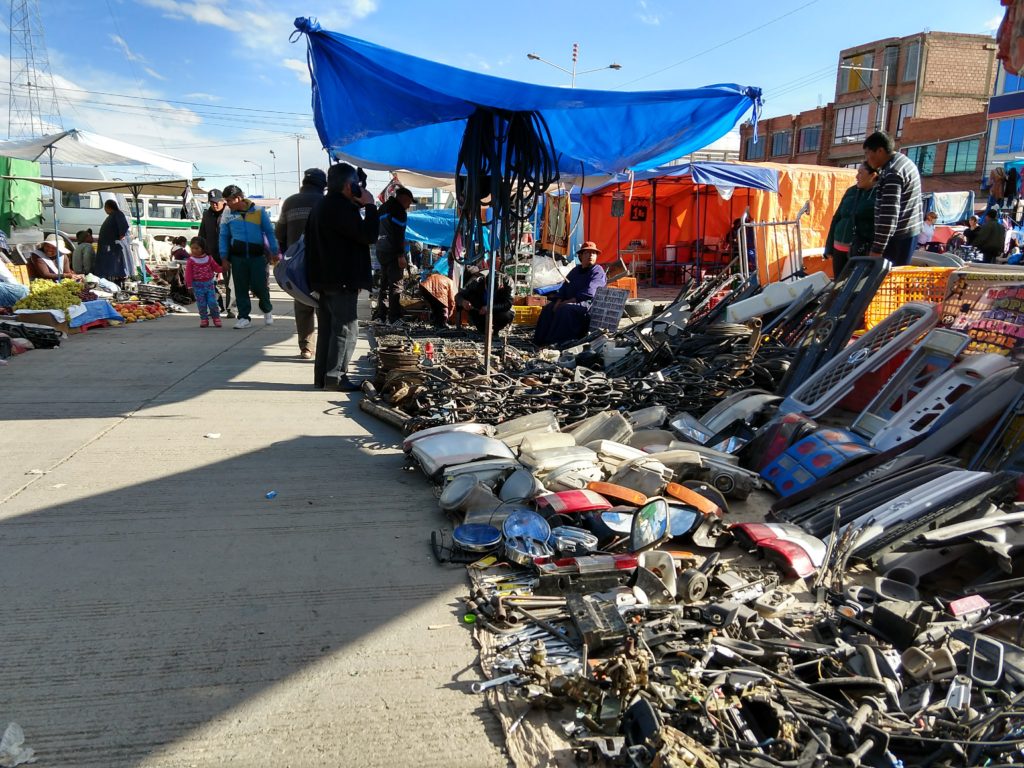
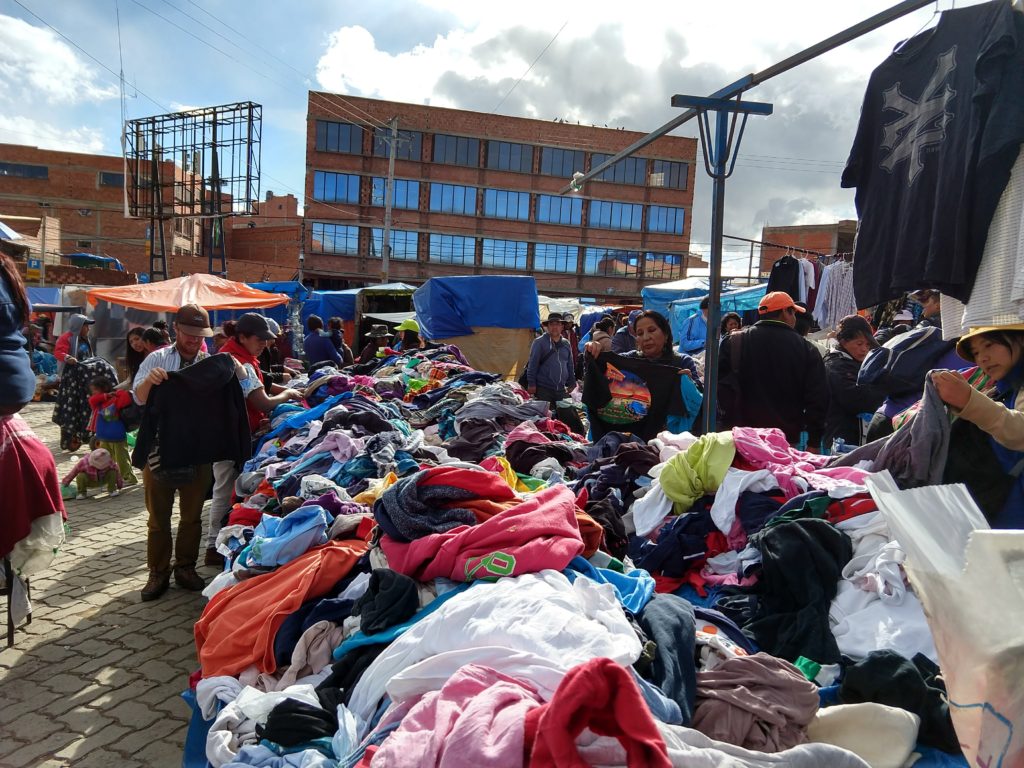 We immediately saw the validity in this assertion after walking among every car part imaginable, computer parts from the 80’s until now and anything else imaginable. Miles upon miles of market existed up and down the streets of the El Alto neighborhood, far too big to explore in one day and best appreciated from a gondola.
We immediately saw the validity in this assertion after walking among every car part imaginable, computer parts from the 80’s until now and anything else imaginable. Miles upon miles of market existed up and down the streets of the El Alto neighborhood, far too big to explore in one day and best appreciated from a gondola.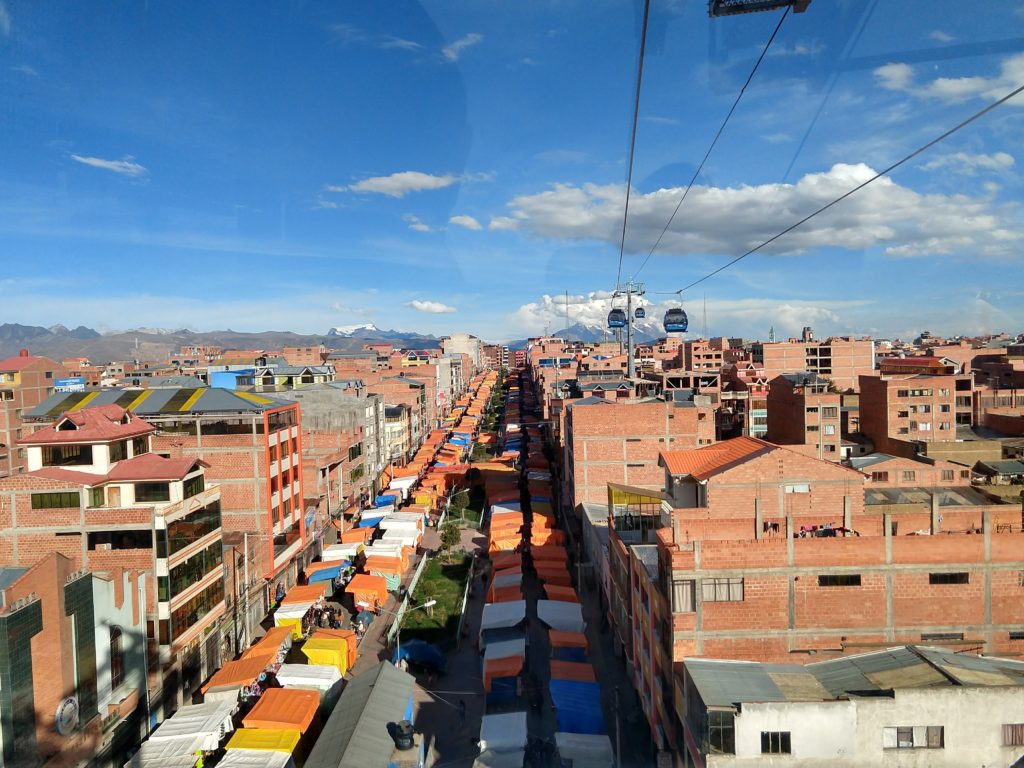
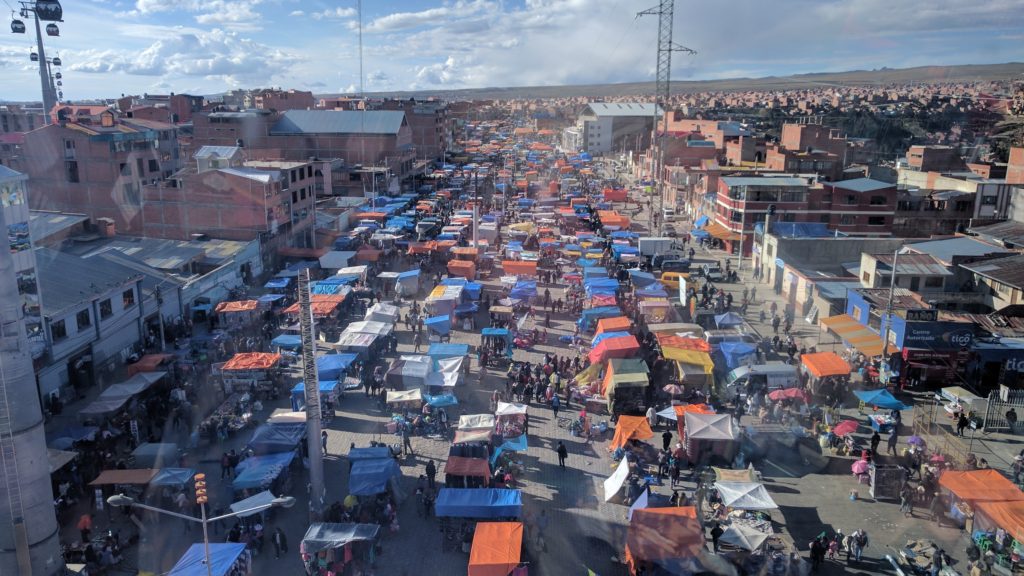 Always looking for exercise options, we found some climbing on the southern edge of the city, so we drove away from the airport avoiding the hole, until we reached the rocks. We spent a day and a half exploring the climbs while we reminisced about the fascinating city from its outskirts.
Always looking for exercise options, we found some climbing on the southern edge of the city, so we drove away from the airport avoiding the hole, until we reached the rocks. We spent a day and a half exploring the climbs while we reminisced about the fascinating city from its outskirts.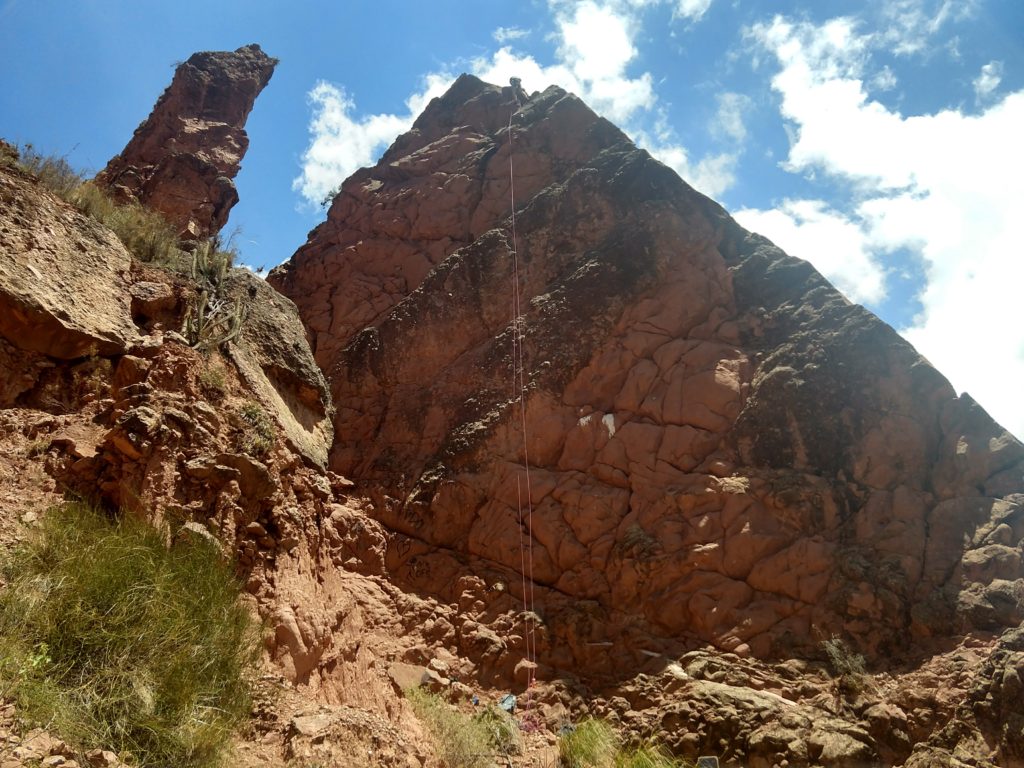 Ironically, close to the climbing is a restaurant opened up by world renowned chef, Claus Meyer, named Gustu. Meyer’s vision is to the change the world through food and its appreciation. He didn’t just open a restaurant in La Paz, but a culinary school which admits only students from poor neighborhoods to teach them how to cook, serve, and manage a restaurant properly. In order to graduate, they must make it through the rigorous work at the world class restaurant, Gustu. On a whim, we walked in and ordered a few plates and it was delicious.
Ironically, close to the climbing is a restaurant opened up by world renowned chef, Claus Meyer, named Gustu. Meyer’s vision is to the change the world through food and its appreciation. He didn’t just open a restaurant in La Paz, but a culinary school which admits only students from poor neighborhoods to teach them how to cook, serve, and manage a restaurant properly. In order to graduate, they must make it through the rigorous work at the world class restaurant, Gustu. On a whim, we walked in and ordered a few plates and it was delicious. 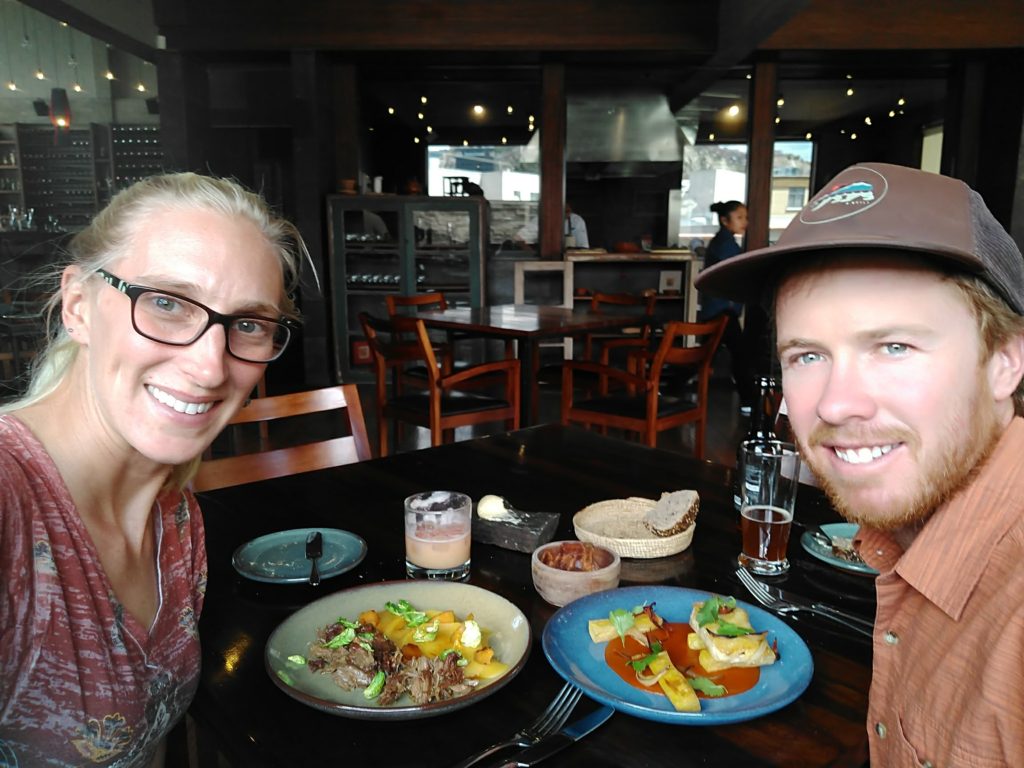 Taste buds dancing, we left the city ready for more open roads and to experience more of the country we’ve already begun to love.
Taste buds dancing, we left the city ready for more open roads and to experience more of the country we’ve already begun to love.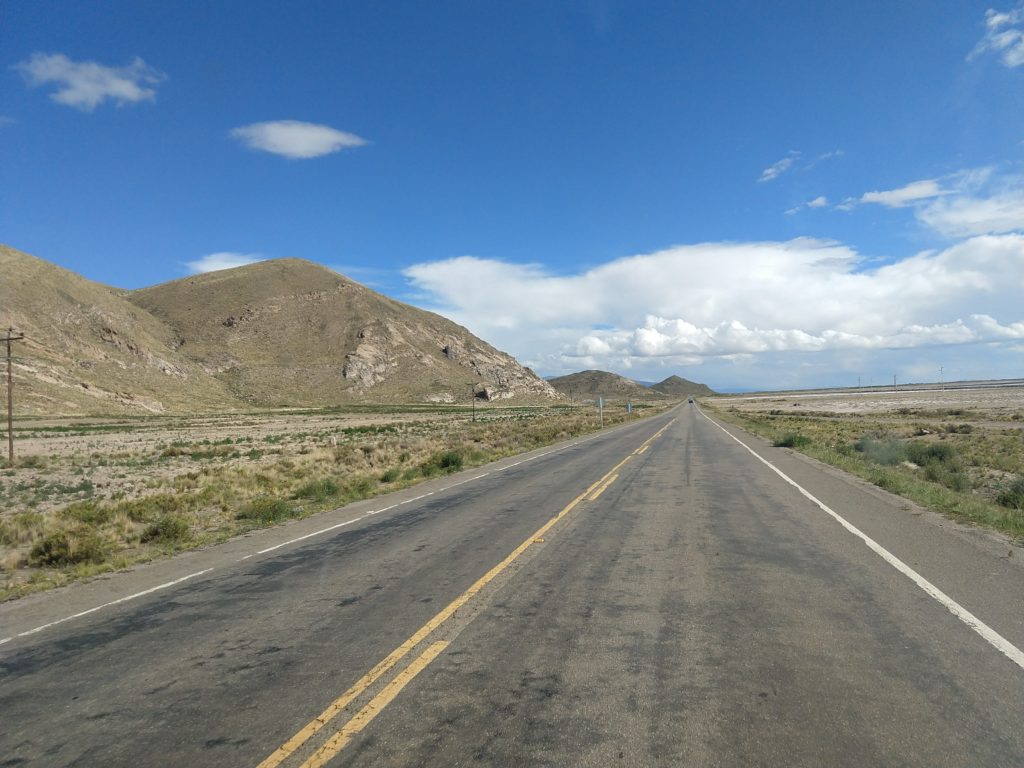
11 thoughts on “Bolivian Beginnings”
We just love your writing‼️ Thanks so much for sharing your adventures‼️?
Thanks Gail! It is so fun sharing our adventure with you! 🙂
Great insight into a country that is off of most folks’ radar. Looks like a fascinating place and you did a nice job of savoring the good stuff.
Thanks Scott. We couldn’t help but enjoy the similarities to the beautiful landscapes of home coupled with the fascinating culture that remains strong. Bolivia is definitely a very special place.
Por cierto..la bendición de los autos es también común aquí, de hecho yo lo hice cuando compré mi carrito.
Es una protección para que nunca te pase nada en el camino, para protegerte de accidentes.
Lo que si es nuevo para mí es la forma que los adornan…tu niño van tiene una corbata..jajaja..me alegro que hayan participado en actividades religiosas de la región. Están experimentando al máximo, la religión se funde con las creencias ancestrales.
Se los felicita amigos queridos.
OMG! the popcorn! Koru looked so fancy. So happy you got to spend some time in Bolivia, i have always heard great things.
Thanks Angie. We still think about the Bolivian popcorn regularly. Best road trip food ever!
La Paz looked fabulous to experience! You seem to find the great places to explore and eat!!
La Paz was indeed a great and unique city to explore. We’ve definitely become interested in savoring the good places while we can.
Qué locura amigos,..jajaajjajaja.casi que no puedo creer…increíble forma de transportar los buses y a la gente a través de este lago….jesucristo..para darme un infarto seguro, porque se ve que son botes nada seguros…ya me imagino que estuvieron en apuros y sufriendo por su casa/ van hasta llegar a la orilla.
qué lástima la pobreza en Bolivia, no veo muchos cambios en la gente.
Parece que el mercado en el que estuvieron había cosas para atraer el amor…para hechizos de amor…jajajaja.
jabón amarre de amor, polvo matrimonial,jabón sígueme sígueme, jabón abre camino es para oportunidades de empleo, alejado de mal de amor es jabón para el engaño.
las empanadas se las ve deliciosas, son muy diferentes a las ecuatorianas, pero en el horno deben ser mucho más saludables…impresionantes porciones de canguil..no sabía lo mucho que se consumía ahi.
Genial este tramo del viaje, con muchas cosas nuevas y que sorprenden a todos.
un abrazo amigos bellos.
bye
Si Paulina! Nos dio un poquito miedo, pero todo salio bien! El magico del viaje es siempre conociendo algo nuevo! XOXO